Abstract
1. In order to develop a predictive model for the preclinical evaluation of anthracycline cardiotoxicity and the means of preventing it, we have studied the functional parameters of perfused hearts isolated from rats receiving repeated doses of several anthracyclines. 2. The anthracyclines studied were doxorubicin, epirubicin, pirarubicin and daunorubicin, and we also studied a liposomal formulation of daunorubicin (DaunoXome) and the co-administration of dexrazoxane (ICRF-187) and doxorubicin. 3. Anthracyclines were administered i.p. at equimolar doses corresponding to 3 mg kg-1 per injection of doxorubicin, every other day for a total of six doses. Dexrazoxane was used at the dose of 30 mg kg-1 per injection and was administered either 30 min before or 30 min after doxorubicin. We evaluated any general toxicity towards the animals as well as alterations of left ventricular contractility and relaxation ex vivo. 4. Epirubicin and daunorubicin were significantly less cardiotoxic than doxorubicin, and neither pirarubicin nor DaunoXome caused significant alterations in cardiac function. There was a direct relationship between the decrease in cardiac contractility or relaxation and anthracycline accumulation in the heart, evaluated after the same treatment schedule. 5. Dexrazoxane induced a significant protection against doxorubicin-induced cardiac toxicity when administered 30 min before doxorubicin, whereas this protection was ineffective when administered 30 min after doxorubicin. Direct perfusion of DaunoXome in isolated hearts of untreated animals resulted in a 12-fold reduction of the accumulation of daunorubicin in heart tissue as compared to the perfusion of free daunorubicin, and did not cause alterations in cardiac function at a dosage for which free daunorubicin induced major alterations. 6. The isolated perfused rat heart appears to be a valuable model for screening of new anthracyclines and of strategies for circumventing anthracycline cardiotoxicity.
Full text
PDF
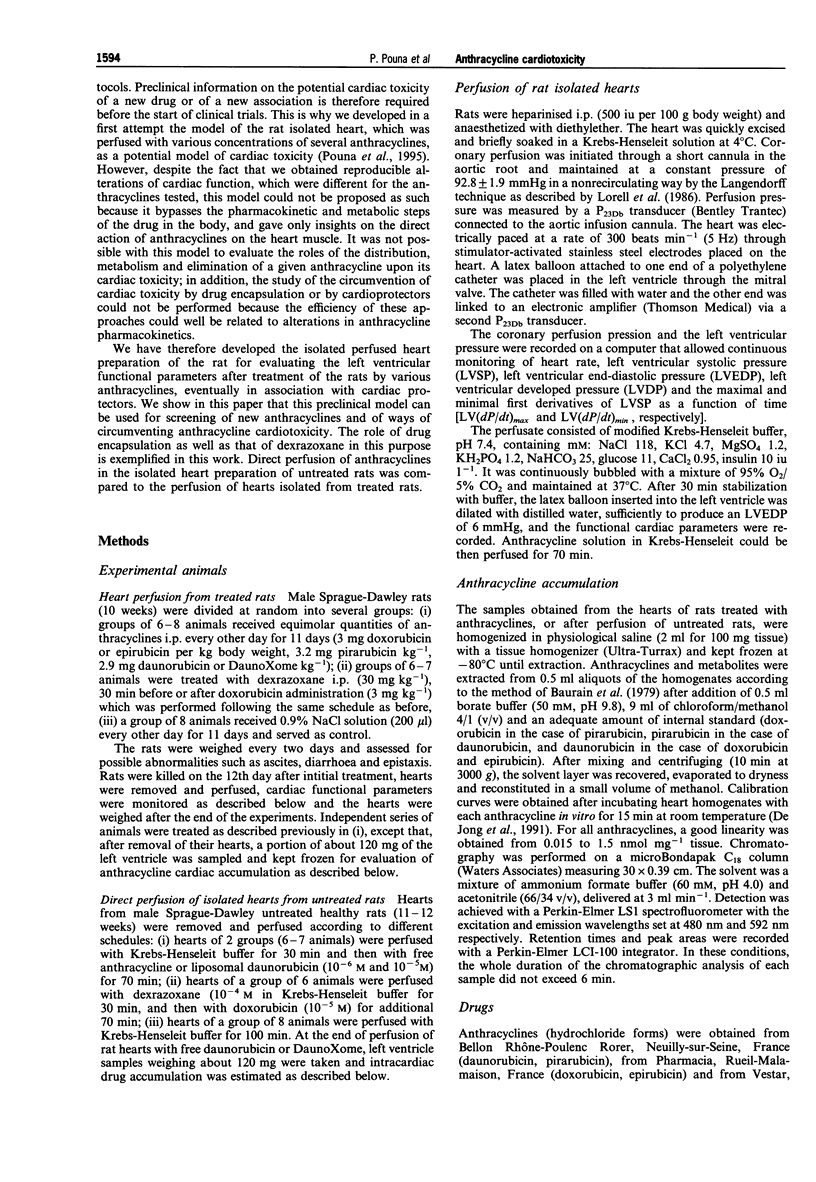
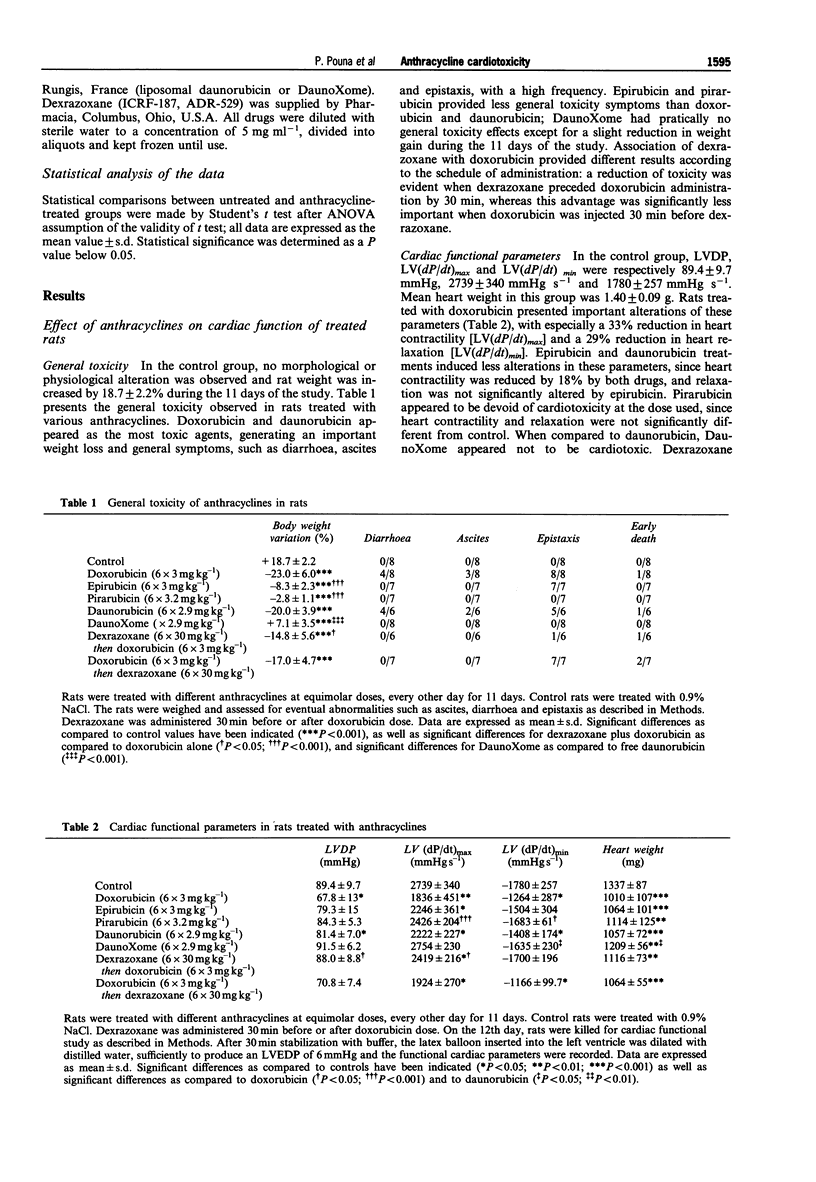
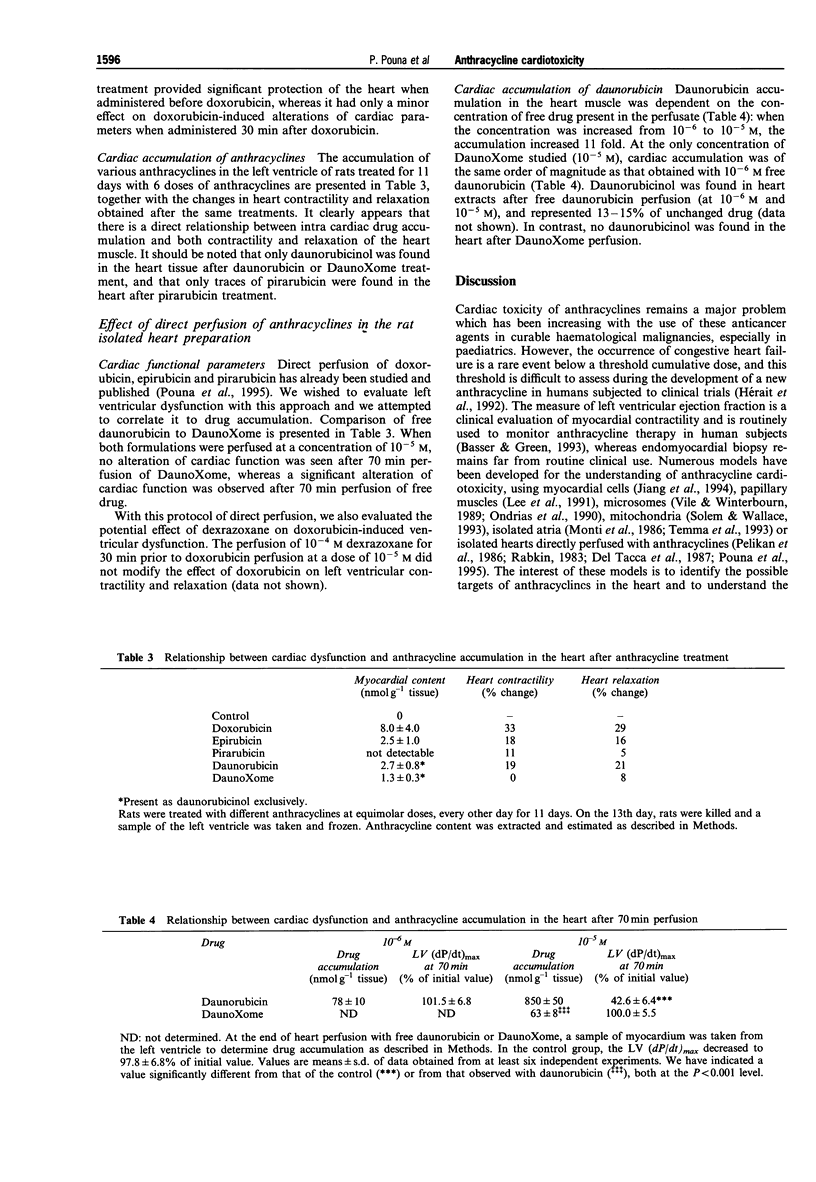
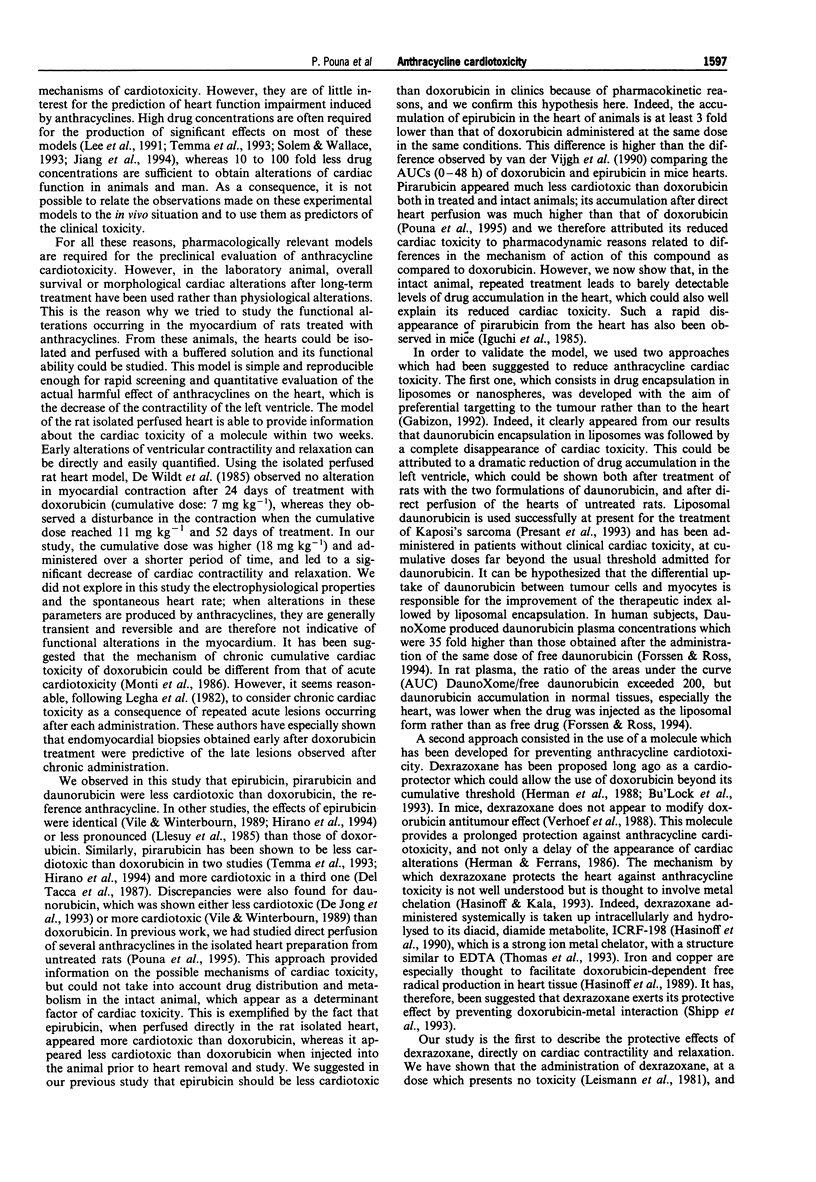
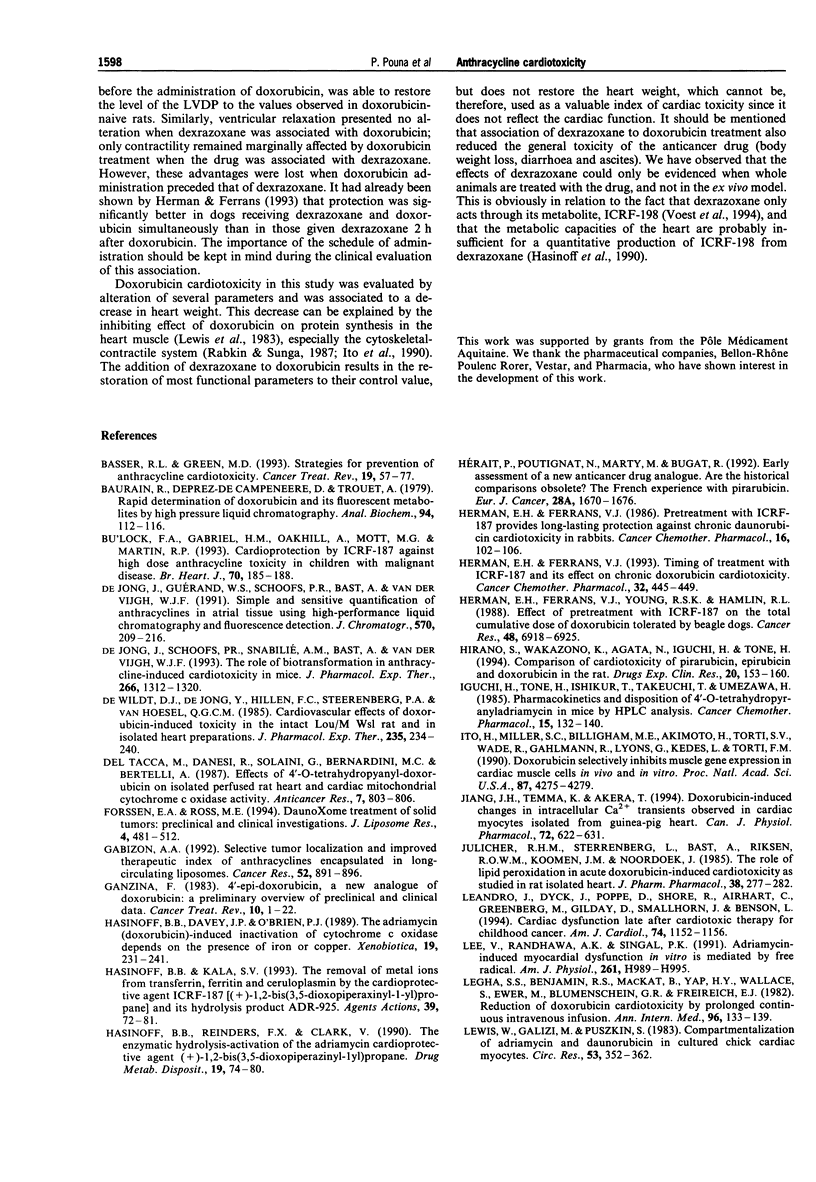
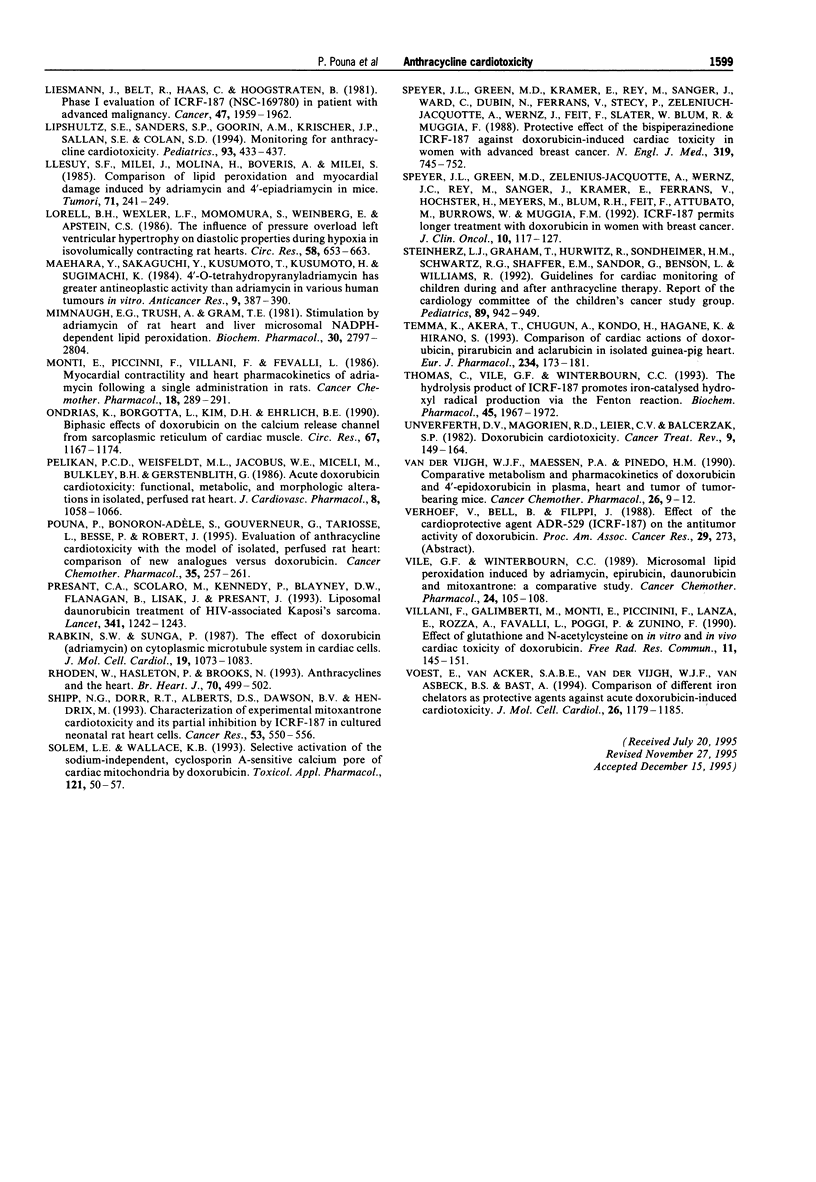
Selected References
These references are in PubMed. This may not be the complete list of references from this article.
- Basser R. L., Green M. D. Strategies for prevention of anthracycline cardiotoxicity. Cancer Treat Rev. 1993 Jan;19(1):57–77. doi: 10.1016/0305-7372(93)90027-o. [DOI] [PubMed] [Google Scholar]
- Baurain R., Deprez-De Campeneere D., Trouet A. Rapid determination of doxorubicin and its fluorescent metabolites by high pressure liquid chromatography. Anal Biochem. 1979 Apr 1;94(1):112–116. doi: 10.1016/0003-2697(79)90799-1. [DOI] [PubMed] [Google Scholar]
- Bu'Lock F. A., Gabriel H. M., Oakhill A., Mott M. G., Martin R. P. Cardioprotection by ICRF187 against high dose anthracycline toxicity in children with malignant disease. Br Heart J. 1993 Aug;70(2):185–188. doi: 10.1136/hrt.70.2.185. [DOI] [PMC free article] [PubMed] [Google Scholar]
- Del Tacca M., Danesi R., Solaini G., Bernardini M., Bertelli A. Effects of 4'-O-tetrahydropyranyl-doxorubicin on isolated perfused rat heart and cardiac mitochondrial cytochrome C oxidase activity. Anticancer Res. 1987 Jul-Aug;7(4B):803–806. [PubMed] [Google Scholar]
- Gabizon A. A. Selective tumor localization and improved therapeutic index of anthracyclines encapsulated in long-circulating liposomes. Cancer Res. 1992 Feb 15;52(4):891–896. [PubMed] [Google Scholar]
- Ganzina F. 4'-epi-doxorubicin, a new analogue of doxorubicin: a preliminary overview of preclinical and clinical data. Cancer Treat Rev. 1983 Mar;10(1):1–22. doi: 10.1016/s0305-7372(83)80029-2. [DOI] [PubMed] [Google Scholar]
- Hasinoff B. B., Davey J. P., O'Brien P. J. The Adriamycin (doxorubicin)-induced inactivation of cytochrome c oxidase depends on the presence of iron or copper. Xenobiotica. 1989 Feb;19(2):231–241. doi: 10.3109/00498258909034696. [DOI] [PubMed] [Google Scholar]
- Hasinoff B. B., Kala S. V. The removal of metal ions from transferrin, ferritin and ceruloplasmin by the cardioprotective agent ICRF-187 [(+)-1,2-bis(3,5-dioxopiperazinyl-1-yl)propane] and its hydrolysis product ADR-925. Agents Actions. 1993 May;39(1-2):72–81. doi: 10.1007/BF01975717. [DOI] [PubMed] [Google Scholar]
- Hasinoff B. B., Reinders F. X., Clark V. The enzymatic hydrolysis-activation of the adriamycin cardioprotective agent (+)-1,2-bis(3,5-dioxopiperazinyl-1-yl)propane. Drug Metab Dispos. 1991 Jan-Feb;19(1):74–80. [PubMed] [Google Scholar]
- Herait P., Poutignat N., Marty M., Bugat R. Early assessment of a new anticancer drug analogue--are the historical comparisons obsolete? The French experience with pirarubicin. Eur J Cancer. 1992;28A(10):1670–1676. doi: 10.1016/0959-8049(92)90066-b. [DOI] [PubMed] [Google Scholar]
- Herman E. H., Ferrans V. J. Pretreatment with ICRF-187 provides long-lasting protection against chronic daunorubicin cardiotoxicity in rabbits. Cancer Chemother Pharmacol. 1986;16(2):102–106. doi: 10.1007/BF00256157. [DOI] [PubMed] [Google Scholar]
- Herman E. H., Ferrans V. J. Timing of treatment with ICRF-187 and its effect on chronic doxorubicin cardiotoxicity. Cancer Chemother Pharmacol. 1993;32(6):445–449. doi: 10.1007/BF00685888. [DOI] [PubMed] [Google Scholar]
- Herman E. H., Ferrans V. J., Young R. S., Hamlin R. L. Effect of pretreatment with ICRF-187 on the total cumulative dose of doxorubicin tolerated by beagle dogs. Cancer Res. 1988 Dec 1;48(23):6918–6925. [PubMed] [Google Scholar]
- Hirano S., Wakazono K., Agata N., Iguchi H., Tone H. Comparison of cardiotoxicity of pirarubicin, epirubicin and doxorubicin in the rat. Drugs Exp Clin Res. 1994;20(4):153–160. [PubMed] [Google Scholar]
- Iguchi H., Tone H., Ishikura T., Takeuchi T., Umezawa H. Pharmacokinetics and disposition of 4'-O-tetrahydropyranyladriamycin in mice by HPLC analysis. Cancer Chemother Pharmacol. 1985;15(2):132–140. doi: 10.1007/BF00257523. [DOI] [PubMed] [Google Scholar]
- Ito H., Miller S. C., Billingham M. E., Akimoto H., Torti S. V., Wade R., Gahlmann R., Lyons G., Kedes L., Torti F. M. Doxorubicin selectively inhibits muscle gene expression in cardiac muscle cells in vivo and in vitro. Proc Natl Acad Sci U S A. 1990 Jun;87(11):4275–4279. doi: 10.1073/pnas.87.11.4275. [DOI] [PMC free article] [PubMed] [Google Scholar]
- Jiang J., Temma K., Akera T. Doxorubicin-induced changes in intracellular Ca2+ transients observed in cardiac myocytes isolated from guinea-pig heart. Can J Physiol Pharmacol. 1994 Jun;72(6):622–631. doi: 10.1139/y94-088. [DOI] [PubMed] [Google Scholar]
- Julicher R. H., Sterrenberg L., Bast A., Riksen R. O., Koomen J. M., Noordhoek J. The role of lipid peroxidation in acute doxorubicin-induced cardiotoxicity as studied in rat isolated heart. J Pharm Pharmacol. 1986 Apr;38(4):277–282. doi: 10.1111/j.2042-7158.1986.tb04566.x. [DOI] [PubMed] [Google Scholar]
- Leandro J., Dyck J., Poppe D., Shore R., Airhart C., Greenberg M., Gilday D., Smallhorn J., Benson L. Cardiac dysfunction late after cardiotoxic therapy for childhood cancer. Am J Cardiol. 1994 Dec 1;74(11):1152–1156. doi: 10.1016/0002-9149(94)90470-7. [DOI] [PubMed] [Google Scholar]
- Lee V., Randhawa A. K., Singal P. K. Adriamycin-induced myocardial dysfunction in vitro is mediated by free radicals. Am J Physiol. 1991 Oct;261(4 Pt 2):H989–H995. doi: 10.1152/ajpheart.1991.261.4.H989. [DOI] [PubMed] [Google Scholar]
- Legha S. S., Benjamin R. S., Mackay B., Ewer M., Wallace S., Valdivieso M., Rasmussen S. L., Blumenschein G. R., Freireich E. J. Reduction of doxorubicin cardiotoxicity by prolonged continuous intravenous infusion. Ann Intern Med. 1982 Feb;96(2):133–139. doi: 10.7326/0003-4819-96-2-133. [DOI] [PubMed] [Google Scholar]
- Lewis W., Galizi M., Puszkin S. Compartmentalization of adriamycin and daunomycin in cultured chick cardiac myocytes. Effects on synthesis of contractile and cytoplasmic proteins. Circ Res. 1983 Sep;53(3):352–362. doi: 10.1161/01.res.53.3.352. [DOI] [PubMed] [Google Scholar]
- Liesmann J., Belt R., Haas C., Hoogstraten B. Phase I evaluation of ICRF-187 (NSC-169780) in patients with advanced malignancy. Cancer. 1981 Apr 15;47(8):1959–1962. doi: 10.1002/1097-0142(19810415)47:8<1959::aid-cncr2820470808>3.0.co;2-x. [DOI] [PubMed] [Google Scholar]
- Lipshultz S. E., Sanders S. P., Goorin A. M., Krischer J. P., Sallan S. E., Colan S. D. Monitoring for anthracycline cardiotoxicity. Pediatrics. 1994 Mar;93(3):433–437. [PubMed] [Google Scholar]
- Llesuy S. F., Milei J., Molina H., Boveris A., Milei S. Comparison of lipid peroxidation and myocardial damage induced by adriamycin and 4'-epiadriamycin in mice. Tumori. 1985 Jun 30;71(3):241–249. doi: 10.1177/030089168507100305. [DOI] [PubMed] [Google Scholar]
- Lorell B. H., Wexler L. F., Momomura S., Weinberg E., Apstein C. S. The influence of pressure overload left ventricular hypertrophy on diastolic properties during hypoxia in isovolumically contracting rat hearts. Circ Res. 1986 May;58(5):653–663. doi: 10.1161/01.res.58.5.653. [DOI] [PubMed] [Google Scholar]
- Maehara Y., Sakaguchi Y., Kusumoto T., Kusumoto H., Sugimachi K. 4'-O-tetrahydropyranyladriamycin has greater antineoplastic activity than adriamycin in various human tumours in vitro. Anticancer Res. 1989 Mar-Apr;9(2):387–389. [PubMed] [Google Scholar]
- Mimnaugh E. G., Trush M. A., Gram T. E. Stimulation by adriamycin of rat heart and liver microsomal NADPH-dependent lipid peroxidation. Biochem Pharmacol. 1981 Oct;30(20):2797–2804. doi: 10.1016/0006-2952(81)90417-2. [DOI] [PubMed] [Google Scholar]
- Monti E., Piccinini F., Villani F., Favalli L. Myocardial contractility and heart pharmacokinetics of adriamycin following a single administration in rat. Cancer Chemother Pharmacol. 1986;18(3):289–291. doi: 10.1007/BF00273406. [DOI] [PubMed] [Google Scholar]
- Ondrias K., Borgatta L., Kim D. H., Ehrlich B. E. Biphasic effects of doxorubicin on the calcium release channel from sarcoplasmic reticulum of cardiac muscle. Circ Res. 1990 Nov;67(5):1167–1174. doi: 10.1161/01.res.67.5.1167. [DOI] [PubMed] [Google Scholar]
- Pelikan P. C., Weisfeldt M. L., Jacobus W. E., Miceli M. V., Bulkley B. H., Gerstenblith G. Acute doxorubicin cardiotoxicity: functional, metabolic, and morphologic alterations in the isolated, perfused rat heart. J Cardiovasc Pharmacol. 1986 Sep-Oct;8(5):1058–1066. [PubMed] [Google Scholar]
- Pouna P., Bonoron-Adèle S., Gouverneur G., Tariosse L., Besse P., Robert J. Evaluation of anthracycline cardiotoxicity with the model of isolated, perfused rat heart: comparison of new analogues versus doxorubicin. Cancer Chemother Pharmacol. 1995;35(3):257–261. doi: 10.1007/BF00686558. [DOI] [PubMed] [Google Scholar]
- Presant C. A., Scolaro M., Kennedy P., Blayney D. W., Flanagan B., Lisak J., Presant J. Liposomal daunorubicin treatment of HIV-associated Kaposi's sarcoma. Lancet. 1993 May 15;341(8855):1242–1243. doi: 10.1016/0140-6736(93)91147-e. [DOI] [PubMed] [Google Scholar]
- Rabkin S. W., Sunga P. The effect of doxorubicin (adriamycin) on cytoplasmic microtubule system in cardiac cells. J Mol Cell Cardiol. 1987 Nov;19(11):1073–1083. doi: 10.1016/s0022-2828(87)80352-8. [DOI] [PubMed] [Google Scholar]
- Rhoden W., Hasleton P., Brooks N. Anthracyclines and the heart. Br Heart J. 1993 Dec;70(6):499–502. doi: 10.1136/hrt.70.6.499. [DOI] [PMC free article] [PubMed] [Google Scholar]
- Shipp N. G., Dorr R. T., Alberts D. S., Dawson B. V., Hendrix M. Characterization of experimental mitoxantrone cardiotoxicity and its partial inhibition by ICRF-187 in cultured neonatal rat heart cells. Cancer Res. 1993 Feb 1;53(3):550–556. [PubMed] [Google Scholar]
- Solem L. E., Wallace K. B. Selective activation of the sodium-independent, cyclosporin A-sensitive calcium pore of cardiac mitochondria by doxorubicin. Toxicol Appl Pharmacol. 1993 Jul;121(1):50–57. doi: 10.1006/taap.1993.1128. [DOI] [PubMed] [Google Scholar]
- Speyer J. L., Green M. D., Kramer E., Rey M., Sanger J., Ward C., Dubin N., Ferrans V., Stecy P., Zeleniuch-Jacquotte A. Protective effect of the bispiperazinedione ICRF-187 against doxorubicin-induced cardiac toxicity in women with advanced breast cancer. N Engl J Med. 1988 Sep 22;319(12):745–752. doi: 10.1056/NEJM198809223191203. [DOI] [PubMed] [Google Scholar]
- Speyer J. L., Green M. D., Zeleniuch-Jacquotte A., Wernz J. C., Rey M., Sanger J., Kramer E., Ferrans V., Hochster H., Meyers M. ICRF-187 permits longer treatment with doxorubicin in women with breast cancer. J Clin Oncol. 1992 Jan;10(1):117–127. doi: 10.1200/JCO.1992.10.1.117. [DOI] [PubMed] [Google Scholar]
- Steinherz L. J., Graham T., Hurwitz R., Sondheimer H. M., Schwartz R. G., Shaffer E. M., Sandor G., Benson L., Williams R. Guidelines for cardiac monitoring of children during and after anthracycline therapy: report of the Cardiology Committee of the Childrens Cancer Study Group. Pediatrics. 1992 May;89(5 Pt 1):942–949. [PubMed] [Google Scholar]
- Temma K., Akera T., Chugun A., Kondo H., Hagane K., Hirano S. Comparison of cardiac actions of doxorubicin, pirarubicin and aclarubicin in isolated guinea-pig heart. Eur J Pharmacol. 1993 Apr 6;234(2-3):173–181. doi: 10.1016/0014-2999(93)90951-d. [DOI] [PubMed] [Google Scholar]
- Thomas C., Vile G. F., Winterbourn C. C. The hydrolysis product of ICRF-187 promotes iron-catalysed hydroxyl radical production via the Fenton reaction. Biochem Pharmacol. 1993 May 25;45(10):1967–1972. doi: 10.1016/0006-2952(93)90005-h. [DOI] [PubMed] [Google Scholar]
- Unverferth D. V., Magorien R. D., Leier C. V., Balcerzak S. P. Doxorubicin cardiotoxicity. Cancer Treat Rev. 1982 Jun;9(2):149–164. doi: 10.1016/s0305-7372(82)80014-5. [DOI] [PubMed] [Google Scholar]
- Vile G. F., Winterbourn C. C. Microsomal lipid peroxidation induced by adriamycin, epirubicin, daunorubicin and mitoxantrone: a comparative study. Cancer Chemother Pharmacol. 1989;24(2):105–108. doi: 10.1007/BF00263129. [DOI] [PubMed] [Google Scholar]
- Villani F., Galimberti M., Monti E., Piccinini F., Lanza E., Rozza A., Favalli L., Poggi P., Zunino F. Effect of glutathione and N-acetylcysteine on in vitro and in vivo cardiac toxicity of doxorubicin. Free Radic Res Commun. 1990;11(1-3):145–151. doi: 10.3109/10715769009109677. [DOI] [PubMed] [Google Scholar]
- Voest E. E., van Acker S. A., van der Vijgh W. J., van Asbeck B. S., Bast A. Comparison of different iron chelators as protective agents against acute doxorubicin-induced cardiotoxicity. J Mol Cell Cardiol. 1994 Sep;26(9):1179–1185. doi: 10.1006/jmcc.1994.1136. [DOI] [PubMed] [Google Scholar]
- de Jong J., Guérand W. S., Schoofs P. R., Bast A., van der Vijgh W. J. Simple and sensitive quantification of anthracyclines in mouse atrial tissue using high-performance liquid chromatography and fluorescence detection. J Chromatogr. 1991 Sep 18;570(1):209–216. doi: 10.1016/0378-4347(91)80218-2. [DOI] [PubMed] [Google Scholar]
- de Jong J., Schoofs P. R., Snabilié A. M., Bast A., van der Vijgh W. J. The role of biotransformation in anthracycline-induced cardiotoxicity in mice. J Pharmacol Exp Ther. 1993 Sep;266(3):1312–1320. [PubMed] [Google Scholar]
- de Wildt D. J., de Jong Y., Hillen F. C., Steerenberg P. A., van Hoesel Q. G. Cardiovascular effects of doxorubicin-induced toxicity in the intact Lou/M Wsl rat and in isolated heart preparations. J Pharmacol Exp Ther. 1985 Oct;235(1):234–240. [PubMed] [Google Scholar]
- van der Vijgh W. J., Maessen P. A., Pinedo H. M. Comparative metabolism and pharmacokinetics of doxorubicin and 4'-epidoxorubicin in plasma, heart and tumor of tumor-bearing mice. Cancer Chemother Pharmacol. 1990;26(1):9–12. doi: 10.1007/BF02940286. [DOI] [PubMed] [Google Scholar]


